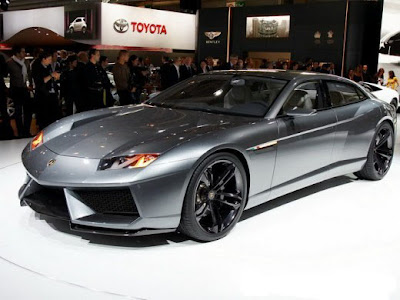Beutifull concept created by Lamborghini specially for the 2008 Paris Motor show. The Lamborghini Estoque has four doors, the first sedan in the history of Automobili Lamborghini. With a powerful front mid-engine, permanent all-wheel drive and a sophisticated, precision-tuned chassis, the Lamborghini Estoque boasts a unique technology package. The design is a little like the Reventon, the brake lamp lighting and the front design. Th e Lamborghini Estoque was shown at the Paris Motor Show 2008.
utorok 30. novembra 2010
štvrtok 25. novembra 2010
Supercar Sharpie Lamborghini Gallardo
Supercar Weekend in Palm Beach Florida included a very unique and one of a kind Sharpie Lamborghini Gallardo. Yes, a Sharpie Lamborghini Gallardo. That is a Lamborghini Gallardo with a Sharpie pen paint job. This is a well known vehicle in the automotive enthusiast community as it has a specially designed exterior done with a sharpie pen. The artwork done by Jona Cerwinske using sharpie markers on the white paint and then finished off with a clear coat to seal the deal.
streda 24. novembra 2010
utorok 23. novembra 2010
Interesting facts about F1 Cars
Here are some interesting facts about F1 Cars
1. An F1 car is made up of 80,000 components, if it were assembled 99.9% correctly; it would still start the race with 80 things wrong!
2. F1 cars have over a kilometer of cable linked to about 100 sensors and actuators which monitor and control many parts of the car.
3. An F1 car can go from 0 to 160 kph AND back to 0 in FOUR seconds!!!!
4. F1 car engines last only for about 2 hours of racing mostly before blowing up on the other hand we expect our engines to last us for a decent 20yrs on an average and they quite faithfully DO....that’s the extent to which the engines r pushed to perform...
5. When an F1 driver hits the brakes on his car he experiences retardation or deceleration comparable to a regular car driving through a BRICK wall at 300kmph!!!
6. An average F1 driver looses about 4kgs of weight after just one race due to the prolonged exposure to high G forces and temperatures for little over an hour (Yeah that’s right!!!)
7. At 550kg a F1 car is less than half the weight of a Mini.
8. In an F1 car the engine typically revs up to 18000 rpm,(the piston traveling up and down 300 times a second!!) whereas cars like the palio, maruti 800,indica rev only up to 6000 rpm at max. That’s 3 times slower.
9. The brake discs in an F1 car have an operating temperature of approximately 1000 degrees Centigrade and they attain that temp while braking before almost every turn...that is why they r not made of steel but of carbon fibre which is much more harder and resistant to wear and tear and most of all has a higher melting point.
10. If a water hose were to blow off, the complete cooling system would empty in just over a second.
11. Gear cogs or ratios are used only for one race, and are replaced regularly to prevent failure, as they are subjected to very high degrees of stress.
12. The fit in the cockpit is so tight that the steering wheel must be removed for the driver to get in or out of the car. A small latch behind the wheel releases it from the column. Levers or paddles for changing gear are located on the back of the wheel. So no
gearstick! The clutch levers are also on the steering wheel, located below the gear paddles.
13. To give you an idea of just how important aerodynamic design and added downforce can be such that small planes can take off at slower speeds than F1 cars travel on the track.
14. Without aerodynamic downforce, high-performance racing cars have sufficient power to produce wheel spin and loss of control at 160 kph. They usually race at over 300 kph.
15. The amount of aerodynamic downforce produced by the front and rear wings and the car underbody is amazing. Once the car is traveling over 160 kph, an F1 car can generate enough downforce to equal its own weight. That means it could actually hold itself to the CEILING of a tunnel and drive UPSIDE down!
16. In a street course race like the Monaco grand prix, the downforce provides enough suction to lift manhole covers. Before the race all of the manhole covers on the streets have to be welded down to prevent this from happening!
17. The refuelers used in F1 can supply 12 liters of fuel per second. This means it would take just 4 seconds to fill the tank of an average 50 litre family-car. They use the same refueling rigs used on US military helicopters today.
18. TOP F1 pit crews can refuel and change tyres in around 3 seconds.
19. Race car tyres don't have air in them like normal car tyres. Most racing tyres have nitrogen in the tyres because nitrogen has a more consistent pressure compared to normal air. Air typically contains varying amounts of water vapor in it, which affects its expansion and contraction as a function of temperature, making the tyre pressure unpredictable.
20. During the race the tyres lose weight! Each tyre loses about 0.5kg in weight due to wear.
21. Normal tyres last 60 000 - 100 000 km. Racing tyres are designed to last 90 - 120 km (That's Khandala and back).
22. A dry-weather F1 tyre reaches peak operating performance (best grip) when tread temperature is between 900C and 1200C. (Water boils at > 100C) At top speed, F1 tyres rotate 50 times a second.
Source of facts
pondelok 22. novembra 2010
Christmas inspiration
Biggest christmas tree of Europe was 75 metres high. (Oporto , Portugal)

Worlds Biggest Christmas Tree - 38,1m 125ft
The biggest Christmas tree display in the world rises up the slopes of Monte Ingino near Gubbio, in Italy’s Umbria region. Each year, on December 7 (Immaculate Conception Eve) the Christmas tree is lit up! This amazing display rises from the last stone houses of Gubbio up to the basilica of S. Ubaldo, the patron saint of the town. More than 500 lights, connected by 40,000 feet of wire comprise this amazing display.
The biggest indoor Christmas tree in China.
The biggest floating Christmas Tree

nedeľa 21. novembra 2010
Top 10 fastest car in the world
1. SSC Ultimate Aero: 257 mph, 0-60 in 2.7 secs. Twin-Turbo V8 Engine with 1183 hp, base price is $654,400. Tested in March 2007 by Guinness world records, The SSC Ultimate Aero takes the lead as the fastest car in the world beating Bugatti Veyron.
2. Bugatti Veyron: 253 mph, 0-60 in 2.5 secs. Aluminum, Narrow Angle W16 Engine with 1001 hp, base price is $1,700,000. With the highest price tag, no wonder this is rank #2.3. Saleen S7 Twin-Turbo: 248 mph, 0-60 in 3.2 secs. Twin Turbo All Aluminum V8 Engine with 750 hp, base price is $555,000. Smooth and bad-ass, will make you want to show it off non-stop.
4. Koenigsegg CCX: 245 mph, 0-60 in 3.2 secs. 90 Degree V8 Engine 806 hp, base price is $545,568. Made in Sweden, it is aiming hard to be the fastest car in the world, but it has a long way to go to surpass the Bugatti and the Ultimate Aero.
5. McLaren F1: 240 mph, 0-60 in 3.2 secs. BMW S70/2 60 Degree V12 Engine with 627 hp, base price is $970,000. Check out the doors, they looks like bat wings, maybe Batman need to order one and paints it black
6. Ferrari Enzo: 217 mph, 0-60 in 3.4 secs. F140 Aluminum V12 Engine with 660 hp, base price is $670,000. Only 399 ever produced, the price goes up every time someone crashes.
7. Jaguar XJ220: 217 mph, 0-60 in 3.8 secs. Twin Turbo V6 Engine with 542 hp, base price was $650,000. Made in 1992, this car still got what it takes to make the list.
8. Pagani Zonda F: 215 mph, 0-60 in 3.5 secs. Mercedes Benz M180 V12 Engine with 650 hp, base price is $667,321. With a V12 motor, this baby can do much better.
9. Lamborghini Murcielago LP640: 211 mph, 0-60 in 3.3 secs. V12 Engine with 640 hp, base price is $430,000. Nice piece of art, the design is very round and smooth.
10. Porsche Carrera GT: 205 mph, 0-60 in 3.9 secs. Aluminum, 68 Degree, Water Cooled V10 Engine with 612 hp, base price is $440,000. The most powerful and most expensive Porsche nearly made the list as #10.
Prihlásiť na odber:
Komentáre (Atom)

























































